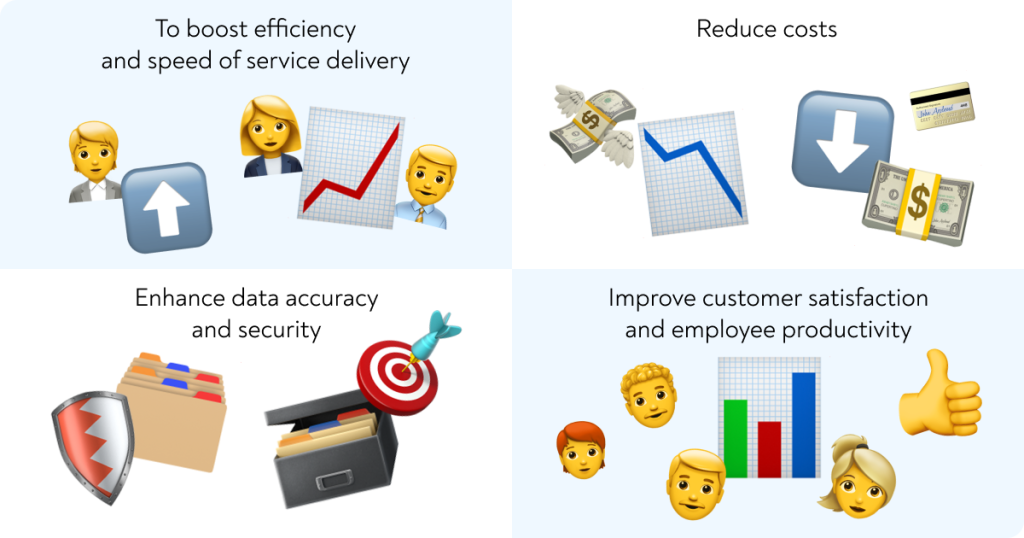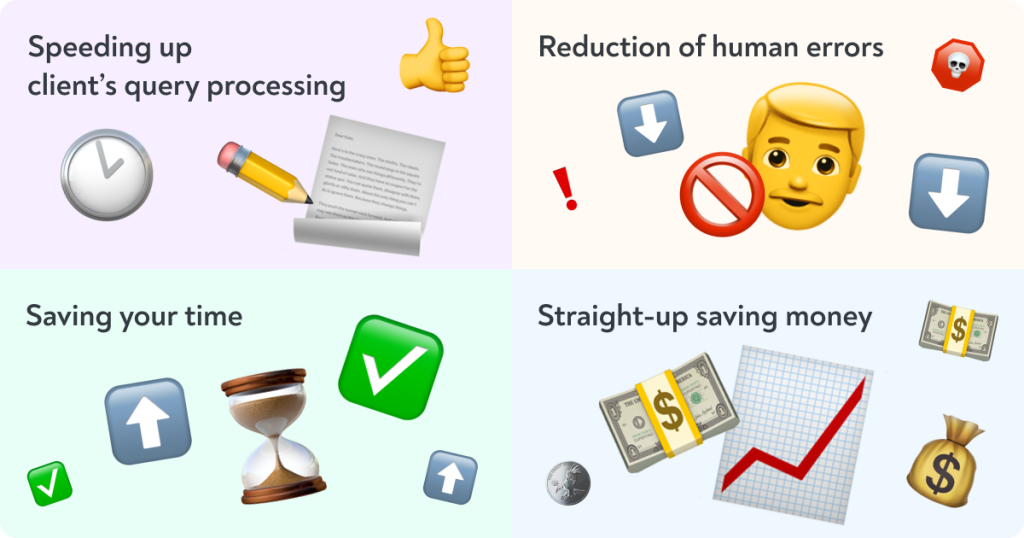Business process automation platforms are now actively used to create reliable, efficient, and repeatable processes and ensure accuracy, quality, and consistency throughout the organization.
The main goals businesses pursue with automation are:
- to boost efficiency and speed of service delivery
- reduce costs
- enhance data accuracy and security
- improve customer satisfaction and employee productivity.
With that, cloud-based solutions are becoming increasingly popular for businesses, as they allow for better scalability and flexibility.
Automation also provides businesses with better insights into operations, customer behavior, and market trends. Thus, Norway-based Helse Vest began using process automation to reduce the administrative burden on its doctors and nurses and was able to save over $488,000 in postage alone.
When to start business automation?
Artificial Intelligence (AI) and Machine Learning (ML) enable businesses to automate complex data analysis and tasks, freeing up IT and other teams to focus on core business goals. AI and ML can also be used to spot trends and make predictions, which is vital when it comes to taking proactive actions to stay ahead of the curve in the market.
To drive efficiency and productivity, start by automating manual processes where it makes the most business sense, like tasks related to promotion, marketing, market research, and customer support.
Then, you can consider automating business processes that are particularly expensive and tedious. Many back-office processes such as invoice processing, payroll, accounts receivable and accounts payable can be incredibly time-consuming and require highly-skilled employees to handle them. Automating these workflows can not only save time and money, but also reduce errors and manual labor costs.
Difference between automation for small businesses and for enterprises
Even microscopic improvements can translate into big sums on a large corporation scale. This can include improved efficiency in logistics, cost savings through inventory and procurement optimization, reduced overhead costs through better management of employees and resources, and increased revenues through improved customer service and sales.
Since many aspects of any business are interconnected, introducing business automation for even small improvements in one area can result in substantial savings in related departments. For example, by improving customer experience, companies can create loyal customer bases and generate repeat business.
Think of it, leading brewer Heineken, which is comprised of 80 operating companies, has managed to save 14,000 hours every single month. This is thanks to the deployment of automation software, mostly used in finance, IT, HR, procurement, and commerce.
At the same time, for many small businesses, investing in expensive software solutions can be impractical. As a rule, small businesses benefit more from the type of automation that can successfully replace human input. From automating data entry and customer service systems to marketing campaigns and inventory control, the business automation can be a powerful tool to help small businesses increase efficiency and remain competitive in the market.
Today’s market offers a slew of cost-effective options that can help the business automate its workflows. These include using cloud-based business solutions such as customer relationship management (CRM), project management software, or enterprise resource planning (ERP) systems.
While you can purchase or subscribe to separate services like Time Tracker or QuickBooks to improve the company’s financial tracking processes, some developers offer simple-to-use full-scale workflow management platforms, which have integrations with popular software like Slack, Jira, XERO, and the aforementioned ones to te the whole process together.
Why is automation not always the best solution?
There is no denying that business process automation solutions ensure faster turnaround time and yield better business results. However, ill-conceived and thoughtless automation may result in unfortunate consequences like unexpected errors and potentially costly losses, as the automated processes may not be able to handle the dynamic business environment.
Additionally, automation failure may lead to the displacement of workers and reduced customer service quality, making the business less competitive, or create silos in the business and limit the business’s ability to quickly scale up or down to adapt to changing customer needs.
Proper planning and implementation are essential for businesses seeking automation. It is important to continuously monitor and measure the performance of automation tools to ensure that they are meeting expected objectives.
5 Dos and Don’ts for business processes automation
Automation tools can provide a significant return on investment (ROI) over time and prove their worth in the long run. For starters, automation allows businesses to streamline administrative tasks such as weekly reports, bank reconciliation, and electronic vendor payments, with some tools ensuring up to 70% shorter approval cycles and up to 80% fewer errors in their accounting records.
By implementing the right automation solutions, businesses can find new ways to streamline processes, increase efficiency, and reduce costs, and here are the things to remember, when choosing a business automation tool or platform:
Do:
1. Invest in the right technology.
invest in the right business process automation technology that meets the needs of your business and is easily scalable. Research the market carefully to find the solution that suits your needs the most, for the best price.
There are multiple platform where you can conduct that research, among the most well-known:
- Capterra
- G2
- FinanceOnline
And if you’re looking for a specific integration, try the marketplace of the vendor you wish it integrate with:
- Slack app directory
- Xero marketplace
- Atlassian marketplace
2. Identify the issues you are dealing with and set clear objectives
Prioritize objectives and use automation to streamline the achievement of those objectives. For example, Amazon uses automation to provide its customers with faster, more efficient deliveries.
It’s clear that in 99% cases automation is implemented to reduce costs. But the way you wish to reduce costs is a decision-making factor here.
Automation can bring:
- Speeding up client’s query processing
- Reduction of human errors (for example, in the accounting records)
- Saving your time (like automated email sequences)
- Straight-up saving money (automating the tasks that can be completed without human input)
The choice of automation software for you will depend on which one of these benefits you’d like to leverage.
3. Plan ahead
Automate with scalability and growth in mind. Calculate future costs and benefits to ensure that you do not outgrow your automation technology too quickly.
4. Automate repetitive tasks
Automating mundane and repetitive tasks that don’t require any decision-making can be done easily with automation tools, like robotic process automation.
5. Collect feedback
Ask customers and employees how they would like their experience to improve and use automation to act on their feedback.
Don’t:
1. Don’t automate without a plan
Business process automation without a plan could lead to inefficient processes, poor customer service, and wasted resources.
2. Don’t underestimate the risk of human error
Automation may help reduce mistakes, but it cannot eliminate them entirely. Be sure to establish clear processes and procedures to prevent errors.
3. Don’t forget to train your staff
Automation software can deliver amazing results in cost reduction and efficiency, but only if your team knows how to properly use and leverage them.
Make sure your team fully understands the tool’s functionality, and the results will inevitably follow.
4. Don’t neglect security:
Automation should not compromise the security of your confidential data or customer information. Make sure to implement security protocols and safeguards to protect against malicious or unauthorized use of automated technology.
5. Don’t sacrifice customer experience
Automation should not come at the expense of customer service. Automation email marketing saves a lot of time, but if the email starts with “Hello, ClientName!” it will not lead you to the desired results.
A strategic approach when considering a business process automation tool is vital, as in some cases, automation may disrupt workflows and processes, making them less efficient than before. Businesses should consider all potential pitfalls, before investing in automation, and develop a clear plan for implementation.
This plan should involve researching available technology, testing different options, and carefully considering how automation will fit with existing processes and workflows and how it will be maintained and supported over time, to ensure the integrity of the system. Moreover, it is important that the team implementing the automation system is well-trained and experienced, and has the capacity to troubleshoot potential problems. This will ensure the system can be implemented and managed effectively, and minimize the risk of automation backfiring.


